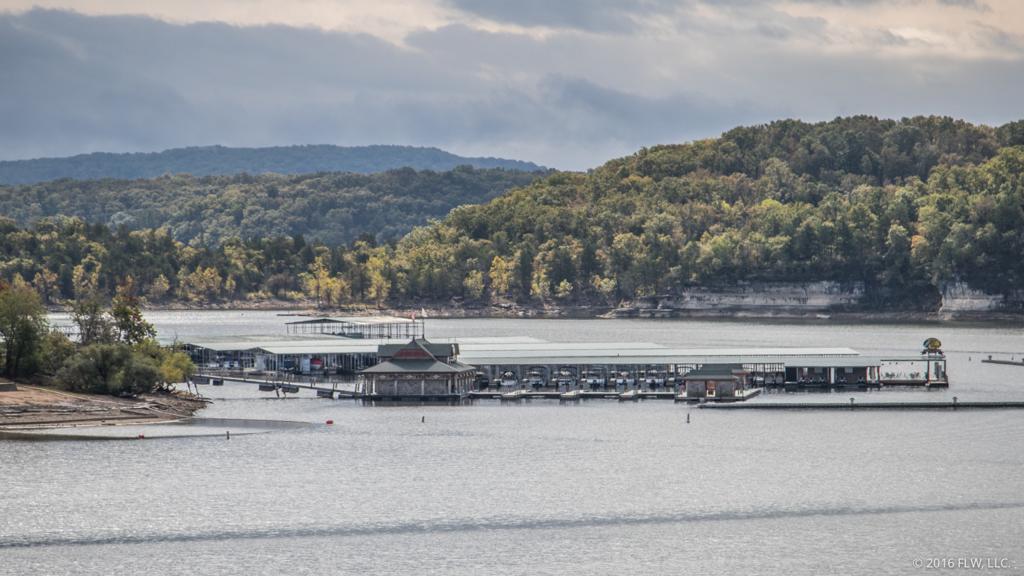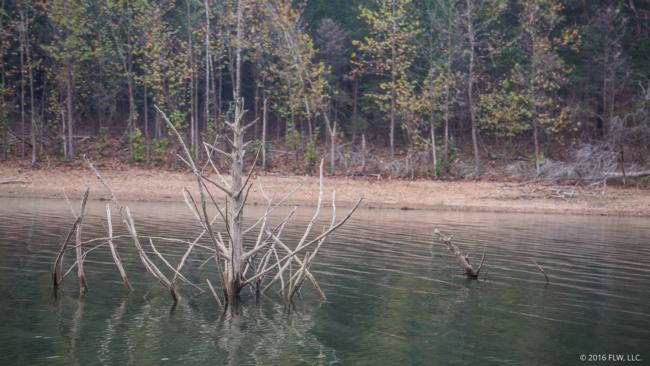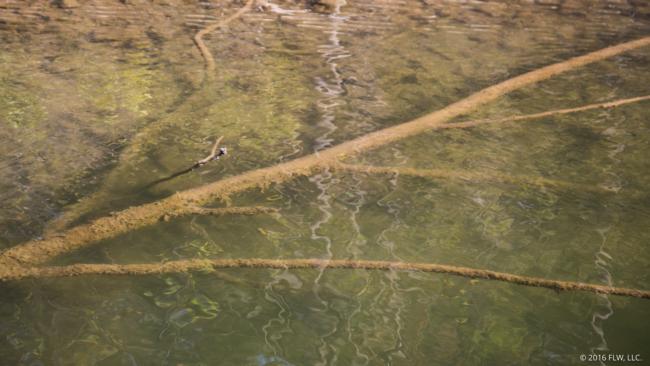3 Key Factors at Table Rock
How water temperature, water level and water clarity could affect the Costa FLW Series Championship

Fall is a tough time to host a championship bass tournament, what with the fish in transition and lake conditions dependent on both long-term and short-term weather patterns.
Then again, some fisheries enjoy a bit of immunity to the fall variables. Table Rock Lake near Branson, Mo., is one of those places. When the Costa FLW Series Championship goes down at Table Rock Nov. 3-5, the fishing will almost certainly be good, but how good really depends on the conditions.
Cape Fair, Mo., angler Kelly Power is one of the top local sources for fishing information at Table Rock. He owns Extreme Outdoors, a tackle shop, and Ulrich Marine, a marine repair center in Branson West, Mo. The winner of the June 2016 FLW Bass Fishing League event at Table Rock, Power is also an accomplished tournament stick.
Power knows exactly what’s happening on Table Rock right now, as well as how this season’s conditions compare to years past. He identified three critical factors that will influence the FLW Series Championship’s outcome.
1. Water level
According to Power, water level management has changed in recent years at Table Rock, and the lake has been kept higher than historic averages, with some fluctuation, obviously.
But in 2016, the water level has been low.
“We’re at 911 [feet above sea level] right now, and it’s been this level all through late summer and early fall,” he says. “I don’t see the lake coming up any.”
How it affects fishing
Table Rock is a rocky, highland reservoir, so the bass relate heavily to natural rocky structure. But they also position around standing timber and shoreline wood cover. With the lower water level, some of the shoreline cover is unfishable, meaning that if bass are relating to wood cover they might be out deeper in brush or timber.
The most notable effect is that anglers can now visually locate and fish cedar trees – a common pattern back before the water was kept up in the cooler months.
“Your No. 1 historically big deal in the fall is fishing cedar trees,” Power reports. “From about 913 to about 910, you can truly see the cedar trees out on the flats. For the last five or six years all that standing timber has been covered because the lake has been higher. This year the standing cedar tree bite could be a player, because those fish, as they’re migrating in from the summer patterns to fall feeding, will use those cedar trees.
“If you get the right conditions – the wind blows, cloudy days, early morning bite – a guy could run cedar trees. Normally, if you catch fish out of those they’re big ones.”
The cedar tree bite is primarily a reaction bite pattern using swimbaits, soft jerkbaits and spinnerbaits.
2. Water temperature
Power says fall is a bit behind in the region, and the water temperature is a little higher than in typical years.
“Normally, by the time FLW gets here, the water temperature should be 62 to 65,” he says. “This year it’s going to be 69 to 73.”
How it affects the fishing
The current forecast shows a cooldown arriving during the tournament, but highs are forecast to be in the low 80s between now and day one.
“It keeps those fish from moving,” says Power of the warm conditions. “They’re starting to move, but if that upper water column doesn’t move down into the mid-60s, the bite is going to be a little tougher, which means the average bite is going to be 10 or 12 feet deep.”
Most anglers who qualified for the championship probably envisioned winding a River2Sea Whopper Plopper or a buzzbait along the bank to catch their fish. In ideal conditions – meaning windy conditions or early morning – that’s absolutely a pattern in play. Yet, Power says it’s not necessarily a pattern that the masses will dial in.
“I do believe whoever wins it is going to win it that way, but it’s not going to be wide open as it normally is,” he says. “If you told me I was fishing this championship, I’m going to go throw it [topwater] for seven hours. I’m going to hope to get five good bites.”
In a couple of recent trips to the lake, Power hammered 22- and 18-pound limits on topwater, but he was dialed in on a very specific pattern that non-locals might not find.
“I didn’t have a fish under 3 pounds. You can’t just go run bank and expect to get that kind of bite,” Power says. “If we’d had our normal cooldown it would’ve been wide open for everybody.
“There’s potential for a handful to do good on the topwater. They just have to be patient or hope the conditions are really conducive, meaning lots of wind. It isn’t going to matter if it’s sunny or cloudy; they’re going to have to have some wind to get multiple bites throughout the day.”
Power predicts that the most consistent bite will be on transition banks and points in the middepth range from about 8 to 15 feet. Shallower patterns will exist where the wind pushes bait into the bank, but his guess is that slowing down with shaky heads, jigs and crankbaits and dialing in on crawfish eaters will produce some top-10 finishes. He also thinks it’s a little late for a true offshore bite.
“The majority of those [offshore] fish have made their move from out deep, but because the water hasn’t cooled they haven’t really gone to the bank like they normally would. They’re just kind of hanging back. I think they’re suspending back in the creeks, and they’re in that transition where on a given day the wind and conditions could put them on the bank, but they’re not all up.”
3. Water clarity
Table Rock is a clear lake, no matter how you slice it. It’s just that this season, there’s what Power calls “a little color” in the system.
“Normally, from the Point 9 area, which is at the mouth of the White and James rivers, to the Long Creek Bridge – that covers the main body on the lake – it’s normally clear. I’m talking 6 to 8 feet of visibility,” says Power. “With the conditions that we’ve had, it’s just never cleared. We don’t get many years that it doesn’t clear. It’s made a difference on the offshore fishing. They just haven’t been there.”
How it affects the fishing
Power thinks the true deep, offshore bite won’t be a factor in the win, due to water clarity and also the fall transition.
He also thinks the clarity will impact some anglers’ preferred finesse tactics.
“What some people have found out is the drop-shot rig isn’t as good because we have color in the lake. Guys who can pick up shaky heads and jigs and can fish points and secondary points and channel swings, they can catch fish. There are some good fish to be had there.”
Power did add that there’s super-clear water way up the White River, which is fed by Beaver Lake.
Final thoughts
As mentioned at the beginning of this article, Table Rock is a stellar fishery regardless of season, and fall can be a prime time to fish there, even if bass aren’t positioned up shallow en masse in a situation where everyone can hammer on them.
“The only thing that could hurt this tournament and make it tough is high bluebird skies and hot weather,” says Power. “If you were to get a major, major cold front, it might slow the bite down a little bit in the morning, but sometime during the day they’re going to put on the feedbag.”


